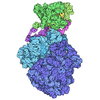+ Open data
Open data
- Basic information
Basic information
| Entry | Database: PDB / ID: 9dno | |||||||||||||||
|---|---|---|---|---|---|---|---|---|---|---|---|---|---|---|---|---|
| Title | Structure of UBR1-RFF complex | |||||||||||||||
 Components Components |
| |||||||||||||||
 Keywords Keywords | PROTEIN BINDING / UBR / E3 ligase / natural ligands | |||||||||||||||
| Function / homology |  Function and homology information Function and homology informationL-leucine binding / ubiquitin-dependent protein catabolic process via the N-end rule pathway / cellular response to L-leucine / negative regulation of TOR signaling / ubiquitin ligase complex / proteasome complex / RING-type E3 ubiquitin transferase / ubiquitin protein ligase activity / Antigen processing: Ubiquitination & Proteasome degradation / proteasome-mediated ubiquitin-dependent protein catabolic process ...L-leucine binding / ubiquitin-dependent protein catabolic process via the N-end rule pathway / cellular response to L-leucine / negative regulation of TOR signaling / ubiquitin ligase complex / proteasome complex / RING-type E3 ubiquitin transferase / ubiquitin protein ligase activity / Antigen processing: Ubiquitination & Proteasome degradation / proteasome-mediated ubiquitin-dependent protein catabolic process / protein ubiquitination / zinc ion binding / cytoplasm / cytosol Similarity search - Function | |||||||||||||||
| Biological species |  Homo sapiens (human) Homo sapiens (human)synthetic construct (others) | |||||||||||||||
| Method |  X-RAY DIFFRACTION / X-RAY DIFFRACTION /  SYNCHROTRON / SYNCHROTRON /  MOLECULAR REPLACEMENT / Resolution: 1.33 Å MOLECULAR REPLACEMENT / Resolution: 1.33 Å | |||||||||||||||
 Authors Authors | Huang, S. / Wu, J. / Taylor, S. / Chen, Y. | |||||||||||||||
| Funding support |  United States, 4items United States, 4items
| |||||||||||||||
 Citation Citation |  Journal: To Be Published Journal: To Be PublishedTitle: Structural Flexibility and Selectivity of N-End Rule Ligases Authors: Huang, S.T. / Wu, J. / Taylor, S. / Chen, Y. | |||||||||||||||
| History |
|
- Structure visualization
Structure visualization
| Structure viewer | Molecule:  Molmil Molmil Jmol/JSmol Jmol/JSmol |
|---|
- Downloads & links
Downloads & links
- Download
Download
| PDBx/mmCIF format |  9dno.cif.gz 9dno.cif.gz | 50.2 KB | Display |  PDBx/mmCIF format PDBx/mmCIF format |
|---|---|---|---|---|
| PDB format |  pdb9dno.ent.gz pdb9dno.ent.gz | 33.3 KB | Display |  PDB format PDB format |
| PDBx/mmJSON format |  9dno.json.gz 9dno.json.gz | Tree view |  PDBx/mmJSON format PDBx/mmJSON format | |
| Others |  Other downloads Other downloads |
-Validation report
| Summary document |  9dno_validation.pdf.gz 9dno_validation.pdf.gz | 3.6 MB | Display |  wwPDB validaton report wwPDB validaton report |
|---|---|---|---|---|
| Full document |  9dno_full_validation.pdf.gz 9dno_full_validation.pdf.gz | 3.6 MB | Display | |
| Data in XML |  9dno_validation.xml.gz 9dno_validation.xml.gz | 11.5 KB | Display | |
| Data in CIF |  9dno_validation.cif.gz 9dno_validation.cif.gz | 15.3 KB | Display | |
| Arichive directory |  https://data.pdbj.org/pub/pdb/validation_reports/dn/9dno https://data.pdbj.org/pub/pdb/validation_reports/dn/9dno ftp://data.pdbj.org/pub/pdb/validation_reports/dn/9dno ftp://data.pdbj.org/pub/pdb/validation_reports/dn/9dno | HTTPS FTP |
-Related structure data
| Related structure data |  9dnpC  9dnqC  9dnrC  9muxC C: citing same article ( |
|---|---|
| Similar structure data | Similarity search - Function & homology  F&H Search F&H Search |
- Links
Links
- Assembly
Assembly
| Deposited unit | 
| ||||||||||
|---|---|---|---|---|---|---|---|---|---|---|---|
| 1 | 
| ||||||||||
| 2 | 
| ||||||||||
| Unit cell |
|
- Components
Components
| #1: Protein | Mass: 8449.517 Da / Num. of mol.: 2 / Fragment: UBR-box domain (UNP residues 97-168) Source method: isolated from a genetically manipulated source Source: (gene. exp.)  Homo sapiens (human) / Gene: UBR1 / Plasmid: pGEX-6p-1-hUBR1-UBRbox Homo sapiens (human) / Gene: UBR1 / Plasmid: pGEX-6p-1-hUBR1-UBRboxDetails (production host): Amp resistance, N-terminal GST tag Production host:  #2: Protein/peptide | Mass: 467.564 Da / Num. of mol.: 2 / Source method: obtained synthetically / Source: (synth.) synthetic construct (others) #3: Chemical | ChemComp-ZN / #4: Water | ChemComp-HOH / | Has ligand of interest | Y | Has protein modification | Y | |
|---|
-Experimental details
-Experiment
| Experiment | Method:  X-RAY DIFFRACTION / Number of used crystals: 1 X-RAY DIFFRACTION / Number of used crystals: 1 |
|---|
- Sample preparation
Sample preparation
| Crystal | Density Matthews: 2.08 Å3/Da / Density % sol: 36.46 % |
|---|---|
| Crystal grow | Temperature: 293.15 K / Method: vapor diffusion, hanging drop / pH: 5.5 Details: The stock concentration of UBR1UBR for co-crystallization is 7.52 mg/ml. The ligand to protein molar ratio for UBR1UBR-RFF co-crystal is 1:2, and the reservoir contains 0.1 M Bis-Tris pH 5.5 ...Details: The stock concentration of UBR1UBR for co-crystallization is 7.52 mg/ml. The ligand to protein molar ratio for UBR1UBR-RFF co-crystal is 1:2, and the reservoir contains 0.1 M Bis-Tris pH 5.5 with 24% PEG 3350. Crystals were soaked in cryoprotection liquid consisting of mother reservoir condition supplemented with 15% glycerol prior to flash freezing in liquid nitrogen. |
-Data collection
| Diffraction | Mean temperature: 77 K / Serial crystal experiment: N |
|---|---|
| Diffraction source | Source:  SYNCHROTRON / Site: SYNCHROTRON / Site:  ALS ALS  / Beamline: 8.2.1 / Wavelength: 1.00002 Å / Beamline: 8.2.1 / Wavelength: 1.00002 Å |
| Detector | Type: DECTRIS PILATUS3 6M / Detector: PIXEL / Date: Apr 11, 2024 |
| Radiation | Protocol: SINGLE WAVELENGTH / Monochromatic (M) / Laue (L): M / Scattering type: x-ray |
| Radiation wavelength | Wavelength: 1.00002 Å / Relative weight: 1 |
| Reflection | Resolution: 1.23→48.97 Å / Num. obs: 36357 / % possible obs: 91.7 % / Redundancy: 5.2 % / Biso Wilson estimate: 15.59 Å2 / Rmerge(I) obs: 0.074 / Net I/σ(I): 10 |
| Reflection shell | Resolution: 1.23→1.25 Å / Mean I/σ(I) obs: 0.1 / Num. unique obs: 909 / CC1/2: 0.053 / % possible all: 45.7 |
- Processing
Processing
| Software |
| |||||||||||||||||||||||||||||||||||||||||||||||||||||||||||||||||||||||||||||
|---|---|---|---|---|---|---|---|---|---|---|---|---|---|---|---|---|---|---|---|---|---|---|---|---|---|---|---|---|---|---|---|---|---|---|---|---|---|---|---|---|---|---|---|---|---|---|---|---|---|---|---|---|---|---|---|---|---|---|---|---|---|---|---|---|---|---|---|---|---|---|---|---|---|---|---|---|---|---|
| Refinement | Method to determine structure:  MOLECULAR REPLACEMENT / Resolution: 1.33→47.8 Å / SU ML: 0.19 / Cross valid method: FREE R-VALUE / σ(F): 1.34 / Phase error: 26.87 / Stereochemistry target values: ML MOLECULAR REPLACEMENT / Resolution: 1.33→47.8 Å / SU ML: 0.19 / Cross valid method: FREE R-VALUE / σ(F): 1.34 / Phase error: 26.87 / Stereochemistry target values: ML
| |||||||||||||||||||||||||||||||||||||||||||||||||||||||||||||||||||||||||||||
| Solvent computation | Shrinkage radii: 0.9 Å / VDW probe radii: 1.1 Å / Solvent model: FLAT BULK SOLVENT MODEL | |||||||||||||||||||||||||||||||||||||||||||||||||||||||||||||||||||||||||||||
| Refinement step | Cycle: LAST / Resolution: 1.33→47.8 Å
| |||||||||||||||||||||||||||||||||||||||||||||||||||||||||||||||||||||||||||||
| Refine LS restraints |
| |||||||||||||||||||||||||||||||||||||||||||||||||||||||||||||||||||||||||||||
| LS refinement shell |
|
 Movie
Movie Controller
Controller



 PDBj
PDBj




